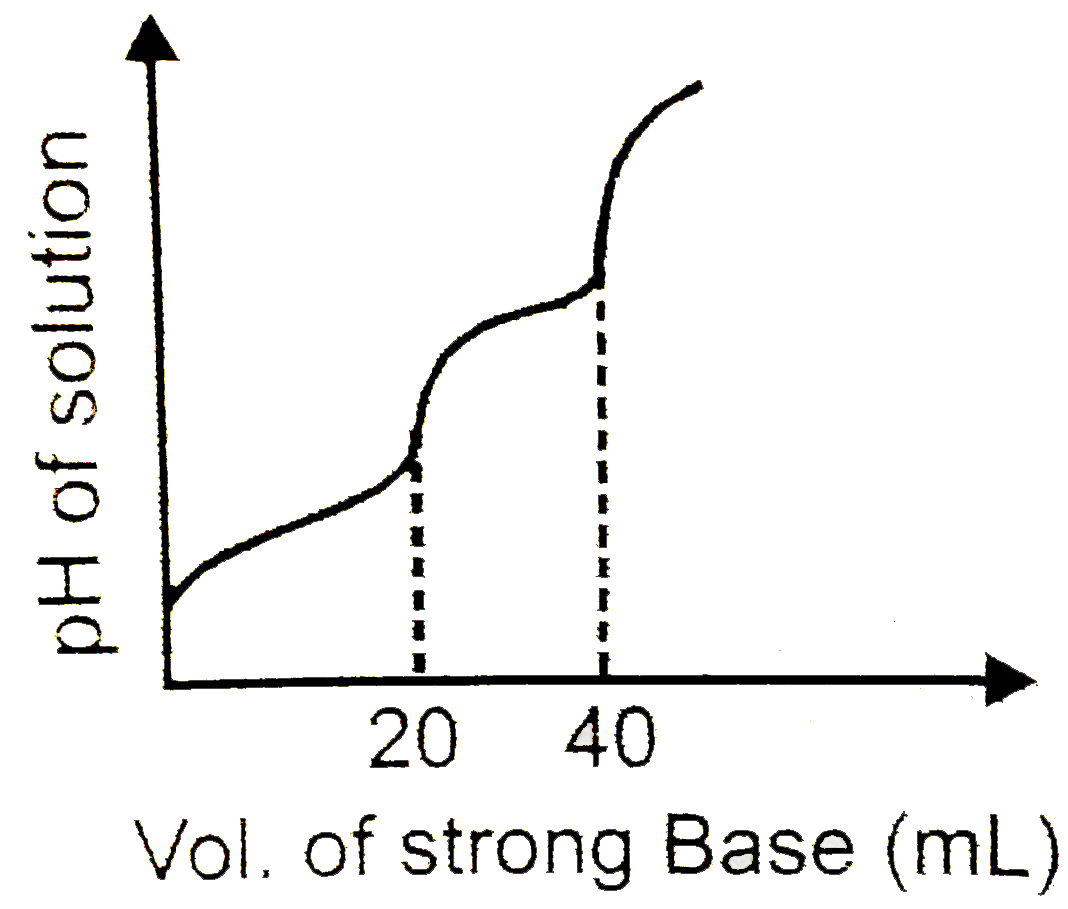During the titration of a weak diprotic acid (H2A) against a strong base (NaOH), the pH of the solution half-way to the first equivalent point and that at the first equivalent point are given respectively by:
pKa1andpKa1+pKa2
√Ka1CandpKa1+pKa22
pKa1andpKa1+pKa22
pKa1andpKa2
The correct Answer is:C
To solve the problem of determining the pH of a weak diprotic acid (H₂A) during its titration with a strong base (NaOH), we will analyze the situation at two specific points: halfway to the first equivalent point and at the first equivalent point.
1. Understanding the Reaction:
- The weak diprotic acid (H₂A) reacts with NaOH to form NaHA (the conjugate base of the first dissociation) and water.
- The reaction can be represented as:
H2A+NaOH→NaHA+H2O
2. Halfway to the First Equivalent Point:
- At halfway to the first equivalent point, half of the H₂A has been neutralized by NaOH.
- If we start with 'A' moles of H₂A, at this point we have:
- Moles of H₂A remaining: A2
- Moles of NaHA formed: A2
- Since we have equal concentrations of the weak acid (NaHA) and its conjugate base (H₂A), we can use the Henderson-Hasselbalch equation for buffer solutions:
pH=pKa1+log((NaHA)(H2A))
- Given that the concentrations of NaHA and H₂A are equal, the log term becomes zero:
pH=pKa1
3. At the First Equivalent Point:
- At the first equivalent point, all of the H₂A has been converted to NaHA.
- The solution now contains only the salt NaHA, which is an amphiprotic salt.
- The pH at this point can be calculated using the average of the two dissociation constants (pK₁ and pK₂):
pH=pKa1+pKa22
4. Summary of Results:
- The pH halfway to the first equivalent point is:
pH=pKa1
- The pH at the first equivalent point is:
pH=pKa1+pKa22
Final Answer:
- The pH halfway to the first equivalent point is pKa1.
- The pH at the first equivalent point is pKa1+pKa22.
- The weak diprotic acid (H₂A) reacts with NaOH to form NaHA (the conjugate base of the first dissociation) and water.
- The reaction can be represented as:
H2A+NaOH→NaHA+H2O
- At halfway to the first equivalent point, half of the H₂A has been neutralized by NaOH.
- If we start with 'A' moles of H₂A, at this point we have:
- Moles of H₂A remaining: A2
- Moles of NaHA formed: A2
- Since we have equal concentrations of the weak acid (NaHA) and its conjugate base (H₂A), we can use the Henderson-Hasselbalch equation for buffer solutions:
pH=pKa1+log((NaHA)(H2A))
- Given that the concentrations of NaHA and H₂A are equal, the log term becomes zero:
pH=pKa1
- At the first equivalent point, all of the H₂A has been converted to NaHA.
- The solution now contains only the salt NaHA, which is an amphiprotic salt.
- The pH at this point can be calculated using the average of the two dissociation constants (pK₁ and pK₂):
pH=pKa1+pKa22
- The pH halfway to the first equivalent point is:
pH=pKa1
- The pH at the first equivalent point is:
pH=pKa1+pKa22
- The pH halfway to the first equivalent point is pKa1.
- The pH at the first equivalent point is pKa1+pKa22.
Topper's Solved these Questions
- IONIC EEQUILIBRIUMBOOK - NARENDRA AWASTHI ENGLISHCHAPTER - IONIC EEQUILIBRIUMEXERCISE - Level- 2
35 Videos
- IONIC EEQUILIBRIUMBOOK - NARENDRA AWASTHI ENGLISHCHAPTER - IONIC EEQUILIBRIUMEXERCISE - Level- 3
19 Videos
- GASEOUS STATEBOOK - NARENDRA AWASTHI ENGLISHCHAPTER - GASEOUS STATEEXERCISE - Subjective problems
15 Videos
- SOLID STATEBOOK - NARENDRA AWASTHI ENGLISHCHAPTER - SOLID STATEEXERCISE - Subjective Problems
13 Videos
Similar Questions
In which of the following acid-base titration, the pH is greater than 8 at the equivalence point ?
View SolutionIn the titration of NH4OH versus HCl, the pH of the solution at equivalence point is about:
View SolutionA weak monobasic acid is half neutralized by a strong base. If the Ph of the solution is 5.4 its pKa is
View SolutionA 20.0 mL sample of a 0.20 M solution of the weak diprotic acid H2A is titrated with 0.250 M NaOH. The concentration of solution at the second equivalent point is:
View SolutionAssertion : In a titration of weak monoprotic acid with strong base, the pH at the half equivalence point is pKa.
Reason : At half equivalence point, it will form acidic buffer at its maximum capacity where [acid]=[salt].
View SolutionWhen a solution of benzoic acid was titrated with NaOH the pH of the solution when half the acid neutralized was 4.2. Dissociation constant of the acid is
View Solution10 mL of H2A(weak diprotic acid) solution is titrated against 0.1M NaOH. pH of the solution is plotted against volume of strong base added and following observation is made. If pH of the solution at first equivalence point is pH1 and at second equivalence point is pH2. Calculate the value of (pH2−pH1) at 25∘C
Given for H2A,pKa1 =4.6 and pKa2 =8, log 25=1.4
View SolutionA strong acid is titrated with weak base. At equivalence point, pH will be :
View SolutionWhy the pH at the equivalence point of a titration may differ from 7 ?
View SolutionAt half - equivalence point in the titration of weak acid by a strong base , pH = …………..
View Solution
